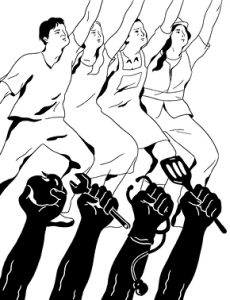Labor, the Working Class, & Socialists
The connection between socialists and the working class predates Karl Marx and Friedrich Engels. With the earliest rumblings of the socialist movement, going back to the French Revolution, socialists focused upon the working class and the poor in the struggle against capitalism and tyranny. What Marx and Engels introduced was a specific way of understanding the working class as a class that could only free itself by freeing society of capitalism.
The working class may have an objective interest in opposing capitalism, but it does not follow that there is an existing socialist consciousness within the class as a whole. The everyday struggles of workers against economic injustice, many of which came to operate within the framework of trade unionism, sought to eliminate the competition between workers engendered by capitalism as a step toward achieving some modicum of economic justice. Unions—as worker organizations fighting for fairness—are necessary because the absolute objective of capitalism is to promote competition between workers and to drive down their living standard in order for the capitalists to expand their profits and ensure social control.
Socialists focus on the working class irrespective of whether it is the majority in any given country. But here is the important qualification. What many revolutionaries appreciated was that when the working class was not the majority, alliances with other oppressed classes were essential. This was especially the question of the relationship of the working class to the peasantry, who, in much of the global South, and up through the early 20th century in the global North, constituted majorities or near majorities.
Lenin framed the task of the working class as one of fighting for consistent democracy. This means that all victims of oppression, whether they are working class or not, must be assisted in their fight for justice. The working class has the challenge of rising above sectoral issues and leading in the building of a larger bloc that can transform society.
What is especially important about the working class is that it brings together people irrespective of race, gender, ethnicity, and so on in a way that most other social settings do not. Peoples that were cut off from one another are brought together by forms of production and work, introducing them to new cultures and new ideas. It is not necessarily a happy coming together. Right-wing populism, for instance, is an illness within the working class and middle strata, frequently responding, in a reactionary way, to developing demographic changes.

Annie Zhao
Socialists additionally recognize the need to transform, in a leftward direction, the official labor movement. This becomes quite complicated precisely because the official labor movement—organized labor—tends to be dominated by an ideology grounded in an acceptance of capitalism, albeit a hoped-for humane variety. Specifically, it is dominated by the ideology of pragmatism.
What is key for all leftists to appreciate is that unions, as well as other forms of labor organization, such as worker centers, can and must be part of the process of social transformation. The nature of these organizations typically makes it impossible for them to be the main instrument of revolutionary change. Unions are united fronts of workers who come together and hold many different political, ideological, and religious views. They are not united on one specific vision. But they can be part of the larger social force that seeks to advance democracy and transformation. Socialists must help to bring that about, while recognizing that they must create a political vehicle that plays the role of a catalytic agent. This political vehicle brings together class and social forces that share a common, strategic interest in an anticapitalist, fundamental, and progressive social transformation.
It is for this reason that the working class needs to be the principal home for the socialist left.
 Democratic Socialists of America
Democratic Socialists of America